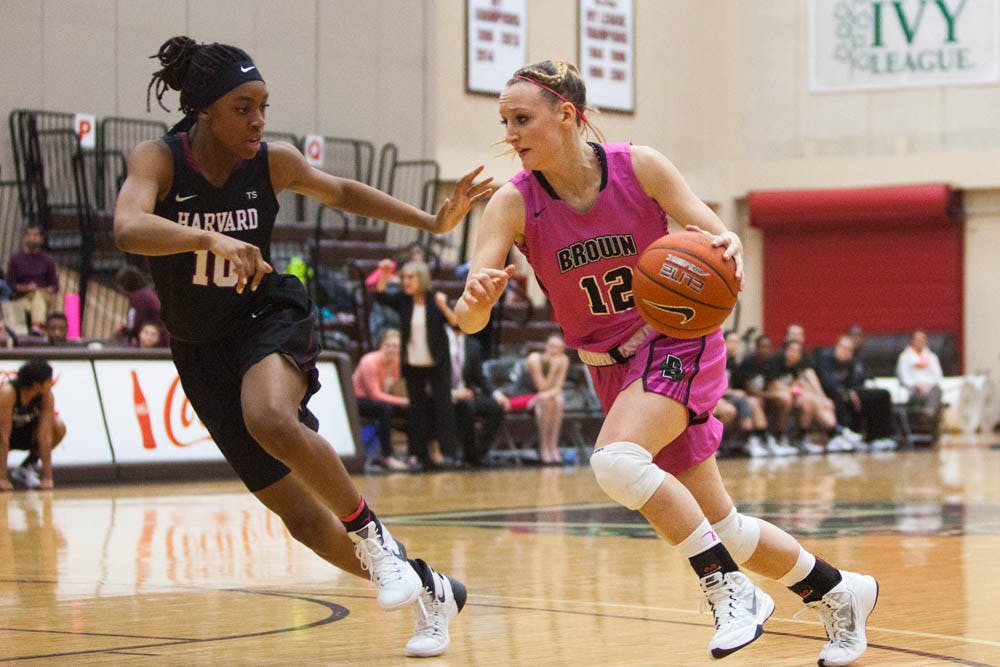The Ivy League, technically, is a Division I conference.
In most ways, though, it’s hard to compare the University to a Power Five conference school. Games typically air on ESPN’s streaming service instead of on cable. Admission is free to every game for students. And despite the best efforts of some students, “Brown State” has never quite caught on.
But aesthetics are perhaps one of the most obvious similarities between Brown and the athletic heavyweights we see in March Madness and the College Football Playoffs. The visual identity maintains cohesion: It’s hard to enter a dining hall or a library and not encounter an athlete in a team-issued parka or hoody emblazoned with an Ivy B and a Nike swoosh. And the uniforms, as a function of the school’s history and status in a Division I athletics conference, have a consistency, a story and an intricate process behind them.
White pants, black belts and the University Boat Club
The history of the University’s athletic uniforms, according to sports historian Peter Mackie ’59, begins with the ill-fated crew race between Brown, Harvard and Yale in 1859.
Despite coming in third place of three, the crew team — not yet a team, but instead titled the University Boat Club — looked sharp, according to Mackie: long-sleeve blue shirts trimmed with white, black-blazed skull caps with the inscription of “Atalanta,” and black belts emblazoned with the letters “UBC.”
The next significant development came in 1878: The 15-man football team, off to play its first ever game at Amherst College, was short on cash. After scraping together $50 — the equivalent of roughly $1,300 today — an enterprising equipment manager went to a downtown tailor to put the uniforms together.
$50, as it turned out, wasn’t enough for the canvas uniforms; the manager left his watch and chain as collateral. The Bears, not even yet known as the Bears, also lost that game.
By 1900, the University did have a mascot, and had started to adopt the obvious color choice. Football, Mackie said, employed “dark brown” uniforms “almost bordering on black.” In 1914, the University added numbers to the back of uniforms for the first time when Bruno played Cornell at the Polo Grounds. (The helmets at that point, Mackie pointed out, were leather almost without any padding.)
“In the 1940s, (football) went to gold pants,” Mackie added. “That was a disaster.”
It was also unusual. “In the 1930s and 1940s, a lot of the uniforms were flat-out dull,” Mackie said. “But they weren’t trying to knock your socks off.”
The University also earned a reputation for patching up its uniforms to save money: Varsity teams would hand down their uniforms to the freshman teams, and fall sports would hand their uniforms off to spring sports. Money for sports, Mackie explained, was tight.
“If you signed out three pairs of white socks and t-shirts,” Mackie said, “you had damn better well have returned them.”
Ever true to (Seal) Brown
By the 1950s, some standardization had set in, according to Mackie. Most uniforms used the official shade of brown — “seal brown” — as well as cardinal red and white in their uniforms.
For women’s teams, split off at the time in Pembroke College, club-varsity teams used what looked like “phys-ed” uniforms before Pembroke merged with the University in 1971.
With colors all but predetermined, much of the change revolved around the logos used on the jerseys. These days, the most consistent feature of a uniform is an arched “Brown'' wordmark, though the University makes four major logos available to its teams, down significantly from the options previously available, which at one point decades ago even included the University’s academic crest.
Today, each team changes its uniforms in a four-year rotation, said Joe Austin, the University’s head equipment manager, ensuring that almost every athlete sees at least one new uniform in their University careers. That leaves room for change and innovation, he explained.
Teams can choose between a pre-designed template, a “semi-custom” design that allows more flexibility with logos and colors and the rare “full custom run,” Austin added. The uniforms are produced by Nike and distributed by BSN Sports, an athletics supply company based out of Massachusetts.
The process typically starts with the coaches, who will either make the choice themselves or engage their team in designing the uniform, sometimes picking one athlete from each class year to have a say in the selection. The process, interim head of athletics Colin Sullivan said, usually takes a matter of weeks.
Women’s soccer, which is in the process of designing new uniforms for next season, is relying on its coaches to lead the process, according to co-captains Malina Yago ‘22 and Cameron Brown ‘21.
The pair expressed their trust in head coach Kia McNeill and her coaching staff to choose a great new look.
“She has a lot of pride in Brown,” Yago said.
“I definitely think it’s exciting any time you get something new,” Brown added. “Brand new uniforms … a brand-new mindset.”
The University typically sticks to brown and white colors — with the option for a dark gray coloring for some sports where uniforms might not come in seal brown or where a third jersey is used, such as in baseball and softball. But women’s soccer, without a brown uniform, is in fact an outlier among other teams that sport all-brown uniforms.
“There’s not many programs that embrace (those colors),” Sullivan said. “It’s not that popular of a color.”
“We try to explain to our athletes and some coaches as well, that Brown is our name, Brown is who we are,” Austin said. “We can stand apart that way.”
Alternate uniforms with unexpected color combinations — like those commonly employed by the University of Oregon or Northwestern University — are also typically out of the question due to budget constraints, Sullivan said. Still, combining a home bottom with an away top (or vice-versa) can create a third or fourth uniform option where only two may have existed before.
“I just don’t know what color (of an alternate uniform) would be,” Brown said — though Yago suggested a red and black kit in the unlikely hypothetical.
The University, though, has made a few exceptions over the years: At one point, women’s basketball wore pink jerseys, funded by a donor for breast cancer awareness. And in 2015, the athletics department issued throwback uniforms for football, field hockey, men’s basketball, women’s basketball, men’s lacrosse and softball to celebrate the University’s 250th birthday. Most of the throwback uniforms incorporated gothic fonts modeled off of the 1970s basketball teams, while the football team’s striped shoulders were an homage to the 1976 Ivy League champions.
Putting it together
The logistics and costs behind outfitting every varsity athlete are complex, Austin said. It’s not just the uniforms: Athletes receive additional gear including sweatshirts, sweatpants, parkas, helmets, G-suits or riding boots, depending on the sport. Most uniforms cost the athletics department between $80 to $125, though specialty items cost more — not to mention the practice gear that some teams also require.
Before arriving at Brown, recruits provide measurements to the University, and most coaches allow athletes to pick their own number. If an athlete misjudges their size, the athletics department can send out the uniforms for alterations.
When athletes actually wear the uniforms, an intense logistical effort goes into keeping them clean: Laundry bins in every locker room go to washers and dryers in every athletic facility. The uniforms then typically return to the locker room the day before competitions — though some teams are issued their uniforms to pack in their own suitcases as they travel to games.
And unless a redesign takes place or the garment sees damage, athletes will typically keep their own uniforms for all four years.
Austin said that he pays less attention to the design of the uniform than the “rips, tears and stains” that take place over a jersey’s lifetime.
“If I watch sports at home, I’m looking more at the sidelines and equipment than the actual play,” Austin added. “Is there enough stretch in the fabric to fit a 300-pound lineman or for a volleyball player to get a good stretch as she’s diving on the floor for a ball?”
Still, Brown said, the actual look of the uniforms — like her team’s all-white kit — can be a source of pride when taking the field for the first time in a season. “It fills you up,” she said.
And while Sullivan said he tends to defer to a “clean” uniform look, Mackie pointed out a difference between this era of University athletics as opposed to every era before. Fans, he noted, might pay as much attention to what an athlete is wearing as to how the athlete is playing.
“People have been more interested in the product on the field than in the color of the uniforms,” Mackie said. “But we live in a much more visual era now, it’s what knocks your socks off.”
“If colorful uniforms would get more kids in the seats at the games, I’d say go for it,” he added.

Will Kubzansky was the 133rd editor-in-chief and president of the Brown Daily Herald. Previously, he served as a University News editor overseeing the admission & financial aid and staff & student labor beats. In his free time, he plays the guitar and soccer — both poorly.





